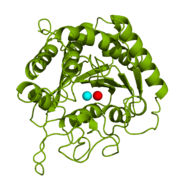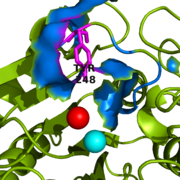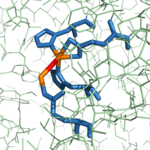Carboxypeptidase A
From Proteopedia
(Difference between revisions)
| Line 43: | Line 43: | ||
==Catalytic and Inhibitory Zinc Binding== | ==Catalytic and Inhibitory Zinc Binding== | ||
[[Image:1CPXhydroxybridge.png|150 px|left|thumb|Figure 4: Hydroxy-bridge between catalytic and inhibitory zinc ions. The catalytic Zn<sup>2+</sup> ion (shown in orange on the right) is bridged to the inhibitory Zn<sup>2+</sup> ion (shown in orange on the left) by a OH<sup>-</sup> (shown in red).]] | [[Image:1CPXhydroxybridge.png|150 px|left|thumb|Figure 4: Hydroxy-bridge between catalytic and inhibitory zinc ions. The catalytic Zn<sup>2+</sup> ion (shown in orange on the right) is bridged to the inhibitory Zn<sup>2+</sup> ion (shown in orange on the left) by a OH<sup>-</sup> (shown in red).]] | ||
| - | As previously stated, <scene name='69/694222/1cpx_default/3'>CPA</scene> from ''B. taurus'' has the ability to bind two Zn<sup>2+</sup> ions in its active site. The binding of only one Zn<sup>2+</sup> ion is [http://en.wikipedia.org/wiki/Catalysis catalytic], while the binding of a second is [http://en.wikipedia.org/wiki/Reaction_inhibitor inhibitory]. These Zn<sup>2+</sup> ions are connected to each other via a hydroxy-bridge (Figure 4) with a distance of 3.48 [http://en.wikipedia.org/wiki/%C3%85ngstr%C3%B6m Å] and in tetrahedral arrangement.<ref name="CPA1" /> In the CPA structure containing only the catalytic Zn<sup>2+</sup> ion (3CPA), a water molecule complexed to the zinc is able to be deprotonated by <scene name='69/694222/3cpas1subsiteglu270/3'>Glu270</scene> to allow for normal initiation of hydrolysis. Again, this water molecule was not crystallized in the structure of 3CPA, but it is shown in Figure 3. However, when <scene name='69/694222/Glu270wiz/8'>the inhibitory zinc ion</scene> is also present ([http://www.rcsb.org/pdb/explore/explore.do?structureId=1cpx 1CPX]), it occupies the physical space that would normally be occupied by the water molecule. Thus, the inhibitory Zn<sup>2+</sup> ion interacts with the carboxylate group of Glu270. The Glu270 (shown in yellow) now simply stabilizes the second Zn<sup>2+</sup> and is unable to perform its usual base catalyst role while the catalytic Zn<sup>2+</sup> ion (shown in cyan) is still being stabilized in place by His69, Glu72, and His196 (shown in orange). Carboxypeptidase A was chemically modified and kinetically assayed to determine its | + | As previously stated, <scene name='69/694222/1cpx_default/3'>CPA</scene> from ''B. taurus'' has the ability to bind two Zn<sup>2+</sup> ions in its active site. The binding of only one Zn<sup>2+</sup> ion is [http://en.wikipedia.org/wiki/Catalysis catalytic], while the binding of a second is [http://en.wikipedia.org/wiki/Reaction_inhibitor inhibitory]. These Zn<sup>2+</sup> ions are connected to each other via a hydroxy-bridge (Figure 4) with a distance of 3.48 [http://en.wikipedia.org/wiki/%C3%85ngstr%C3%B6m Å] and in tetrahedral arrangement.<ref name="CPA1" /> In the CPA structure containing only the catalytic Zn<sup>2+</sup> ion (3CPA), a water molecule complexed to the zinc is able to be deprotonated by <scene name='69/694222/3cpas1subsiteglu270/3'>Glu270</scene> to allow for normal initiation of hydrolysis. Again, this water molecule was not crystallized in the structure of 3CPA, but it is shown in Figure 3. However, when <scene name='69/694222/Glu270wiz/8'>the inhibitory zinc ion</scene> is also present ([http://www.rcsb.org/pdb/explore/explore.do?structureId=1cpx 1CPX]), it occupies the physical space that would normally be occupied by the water molecule. Thus, the inhibitory Zn<sup>2+</sup> ion interacts with the carboxylate group of Glu270. The Glu270 (shown in yellow) now simply stabilizes the second Zn<sup>2+</sup> and is unable to perform its usual base catalyst role while the catalytic Zn<sup>2+</sup> ion (shown in cyan) is still being stabilized in place by His69, Glu72, and His196 (shown in orange). Carboxypeptidase A was chemically modified and kinetically assayed to determine its Zn<sup>2+</sup> kinetic binding constants. As expected, literature showed the K<sub>d</sub> value of the catalytic Zn<sup>2+</sup> to be two orders of magnitude less than the K<sub>d</sub> value of the inhibitory Zn<sup>2+</sup> (K<sub>d</sub> = 2.6x10<sup>-6</sup>M for catalytic Zn<sup>2+</sup>, and 5.5x10<sup>-4</sup>M for inhbitory Zn<sup>2+</sup> at pH = 8.2). This signifies that the catalytic Zn<sup>2+</sup> is approximately 100x more likely to bind to CPA compared to the inhibitory Zn<sup>2+</sup>. |
<ref name=“Binding”>Hirose, J., Noji, M., Kidani, Y., Wilkins, R. 1985. Interaction of zinc ions with arsanilazotyrosine-248 carboxypeptidase A.''Biochemistry''. 24(14):3495-3502. [http://pubs.acs.org/doi/abs/10.1021/bi00335a016 DOI:10.1021/bi00335a016]</ref> | <ref name=“Binding”>Hirose, J., Noji, M., Kidani, Y., Wilkins, R. 1985. Interaction of zinc ions with arsanilazotyrosine-248 carboxypeptidase A.''Biochemistry''. 24(14):3495-3502. [http://pubs.acs.org/doi/abs/10.1021/bi00335a016 DOI:10.1021/bi00335a016]</ref> | ||
Revision as of 14:46, 18 April 2017
| This Sandbox is Reserved from 02/09/2015, through 05/31/2016 for use in the course "CH462: Biochemistry 2" taught by Geoffrey C. Hoops at the Butler University. This reservation includes Sandbox Reserved 1051 through Sandbox Reserved 1080. |
To get started:
More help: Help:Editing |
Carboxypeptidase A in Bos taurus
| |||||||||||
References
- ↑ 1.00 1.01 1.02 1.03 1.04 1.05 1.06 1.07 1.08 1.09 1.10 1.11 1.12 Bukrinsky JT, Bjerrum MJ, Kadziola A. 1998. Native carboxypeptidase A in a new crystal environment reveals a different conformation of the important tyrosine 248. Biochemistry. 37(47):16555-16564. DOI: 10.1021/bi981678i
- ↑ 2.0 2.1 2.2 2.3 2.4 2.5 2.6 Christianson DW, Lipscomb WN. 1989. Carboxypeptidase A. Acc. Chem. Res. 22:62-69.
- ↑ Suh J, Cho W, Chung S. 1985. Carboxypeptidase A-catalyzed hydrolysis of α-(acylamino)cinnamoyl derivatives of L-β-phenyllactate and L-phenylalaninate: evidence for acyl-enzyme intermediates. J. Am. Chem. Soc. 107:4530-4535. DOI: 10.1021/ja00301a025
- ↑ Hirose, J., Noji, M., Kidani, Y., Wilkins, R. 1985. Interaction of zinc ions with arsanilazotyrosine-248 carboxypeptidase A.Biochemistry. 24(14):3495-3502. DOI:10.1021/bi00335a016
- ↑ Geoghegan, KF, Galdes, A, Martinelli, RA, Holmquist, B, Auld, DS, Vallee, BL. 1983. Cryospectroscopy of intermediates in the mechanism of carboxypeptidase A. Biochem. 22(9):2255-2262. DOI: 10.1021/bi00278a031
- ↑ Kaplan, AP, Bartlett, PA. 1991. Synthesis and evaluation of an inhibitor of carboxypeptidase A with a Ki value in the femtomolar range. Biochem. 30(33):8165-8170. PMID: 1868091
- ↑ Worthington, K., Worthington, V. 1993. Worthington Enzyme Manual: Enzymes and Related Biochemicals. Freehold (NJ): Worthington Biochemical Corporation; [2011; accessed March 28, 2017]. Carboxypeptidase A. http://www.worthington-biochem.com/COA/
- ↑ Pitout, MJ, Nel, W. 1969. The inhibitory effect of ochratoxin a on bovine carboxypeptidase a in vitro. Biochem. Pharma. 18(8):1837-1843. DOI: 0.1016/0006-2952(69)90279-2
- ↑ Normant, E, Martres, MP, Schwartz, JC, Gros, C. 1995. Purification, cDNA cloning, functional expression, and characterization of a 26-kDa endogenous mammalian carboxypeptidase inhibitor. Proc. Natl. Acad. Sci. 92(26):12225-12229. PMCID: PMC40329
Student Contributors
- Thomas Baldwin
- Michael Melbardis
- Clay Schnell
Proteopedia Page Contributors and Editors (what is this?)
Michael Melbardis, Douglas Schnell, Thomas Baldwin, Geoffrey C. Hoops, Michal Harel




